|
Bf
109E-1 W.Nr. 4034... maybe |
Every once in a while,
something truly extraordinary pops up out of nowhere... or in the most unlikely
of places. For instance, who would have thought to look in India for a
Messerschmitt? What you see before you is that rarest of treasures... an
almost intact Bf109E-1 still carrying remnants of its original markings from
1./JG77 based at Breslau-Schöngarten, as well as its later schemes of
"black 5" and "black 6".
While the original service unit of the aircraft has been established, the later history of the aircraft is still
somewhat murky, and in fact a definitive W.Nr. has yet to be established for this... naturally, the data plate on the port forward fuselage has vanished, and it will take some dedicated hands-on research of the airframe to find other indications which give a clear answer as to the actual identity of the airframe.
That said, however, there's been much speculation that this may in fact be the machine of Fw. Xavier Ray of
8./JG53, Bf109E-1/b W.Nr. 4034. There are several items which seem to point to this, and we'll begin by quoting directly from the Crashed Enemy Aircraft Report (CEAR) kindly transcribed by Dave Wadman:
Report No.3/139
Me 109 crashed on 2/11/40 at 0905hrs near Lower Hardres. Map reference R.5601. Markings 6+I. All in black outlined white. Camouflage yellow dappled green grey all over. Vertical red band 10" wide round centre of engine cowling. Spinner red without usual hole at the tip. Airframe made by Focke-Wulf, Bremen in 1939. Works number 4034. Engine D.B.601 Work number 10256. Made by D.B. Genshagen.
Cause of crash of this aircraft is not known but pilot made very good belly landing and aircraft is practically intact. No trace of bullet strikes or engine overheating but cause of landing may have been engine failure. Armament, 4 M.G. 17s; no ammunition used. Armour: fuselage cross bulkhead fitted and head protection with curved head shield. Pilot prisoner.
In addition to the above, kindly transcribed by Dave Wadman,
we also have the pilot's interrogation report, with some interesting
observations:
2/11/40 Street End, Canterbury. Fw. Xavier Ray, Me 109E,
‘Black 6’, red spinner, yellow cowling and rudder, 8./JG 53. The mission was
a free-lance patrol to the outskirts of London and the identity of the unit was
obtained by interrogation but this pilot was already known to this section from
a combat report dated 27/9/40 in which it was claimed he shot down two British
aircraft, the witness to this was Oblt. Fiel who himself was shot down on
2/10/40. AIK report 680/1940. The pilot made a forced landing in a ploughed
field owing to engine trouble on the inward flight to London. He stated that his
aircraft, Works number 4034 had given trouble yesterday, and although repairs
had been carried out, it was not running well when he started off today. He said
that although his aircraft was fitted for bombing he did not carry bombs and
that the racks were going to be removed because they slowed the aircraft down.
His morale was high and he would say very little but is probably reliable. He
was extremely annoyed that his aircraft had let him down.
Fw.
Ray did in fact survive the war, and it's mildly amusing to consider whether he
ever purchased a Mercedes-Benz after the war, given his negative experience with
the last Daimler-Benz product he "drove"...
Now, with this information in hand, let's look at the evidence as we have it at the moment:
|
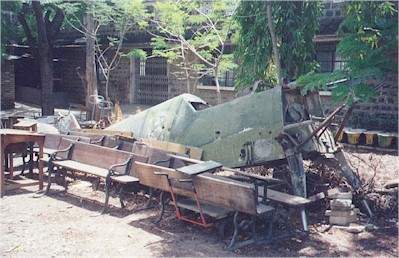
|
This first photo gives us a front quarter overview of the aircraft as it sat in a courtyard in India... imagine, if you will, finding this tucked up amongst lawn furniture, logs, and other assorted ephemera...
What's immediately evident is the excellent condition of the aircraft, as well as the original splinter camouflage showing... other photos will show that this camo and the airframe primer has weathered extremely well, considering the 60 years spent in the harsh Indian climate! |
|
And now we see some of the fascinating markings still evident on the aircraft... the remnants of the "5" and "6" (one atop the other) are evident here, as well as the Balkankreuz. The marking aft of this has been speculated to be a white stripe; however, if one looks at the picture of the III./JG53 Adjutant's aircraft a bit further down the page, it will be seen that this is in the same position and is very similar to the III. Gruppe bar- one of the clues I feel helps point towards the ID of this airframe as 4034. Also evident is the remnants of the field-applied 65 scheme and the lower part of the later, larger Balkankreuz applied between stations 5 and 7.
Photo credit: A.A. Laxman |
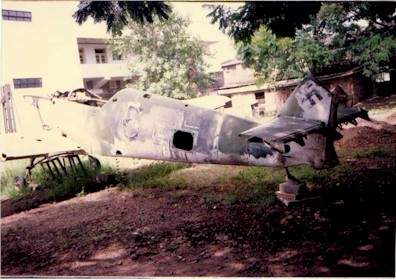
|
|
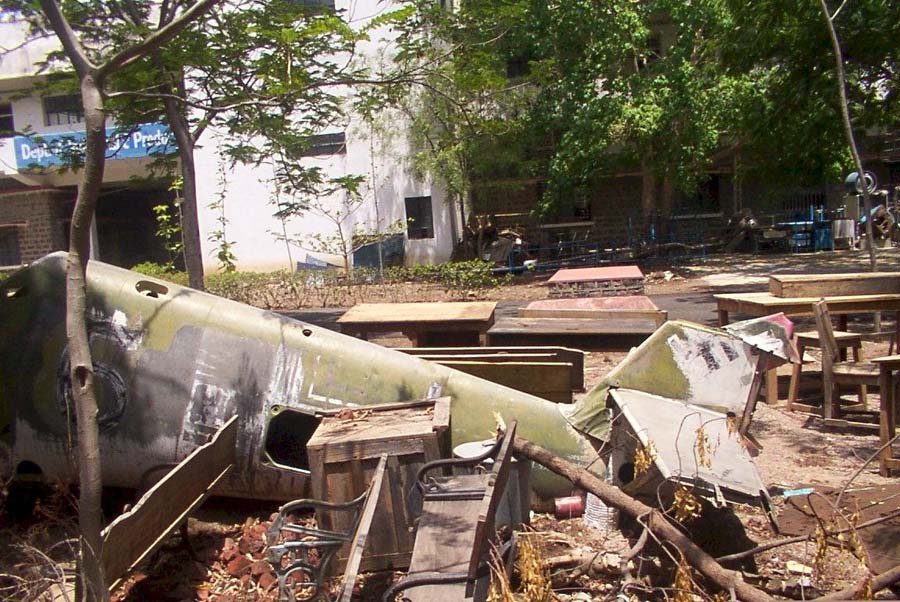
|
The plot thickens... Here we can see a decent overview of the port side of the aircraft, and the top end of the alleged "stripe" can be seen, as can remnants of black paint on it... more thoroughly confirming my suspicions of a III. Gruppe marking. The tail shows not just remnants of the 65 overpainting, but the lower arm of the centrally-mounted original Hakenkreuz is visible as well. The kennzeichen can be
seen in good detail here; the upper swoop of the "6" can be seen to go over the "5", and the ghost of an octane triangle seems to be evident there as well. Most interesting, though, are the fuselage cross outlines; the white outlines visible have a similar proportion to that on the
III./JG53 adjutant's Emil illustrated a bit further down the page. |
|
Here's an interesting closeup of the block casting numbers on the DB601 engine; also worthy of note for the details of the engine mount. No real
solid clues to the ID of the airframe to be found in this pic, I'm afraid... |
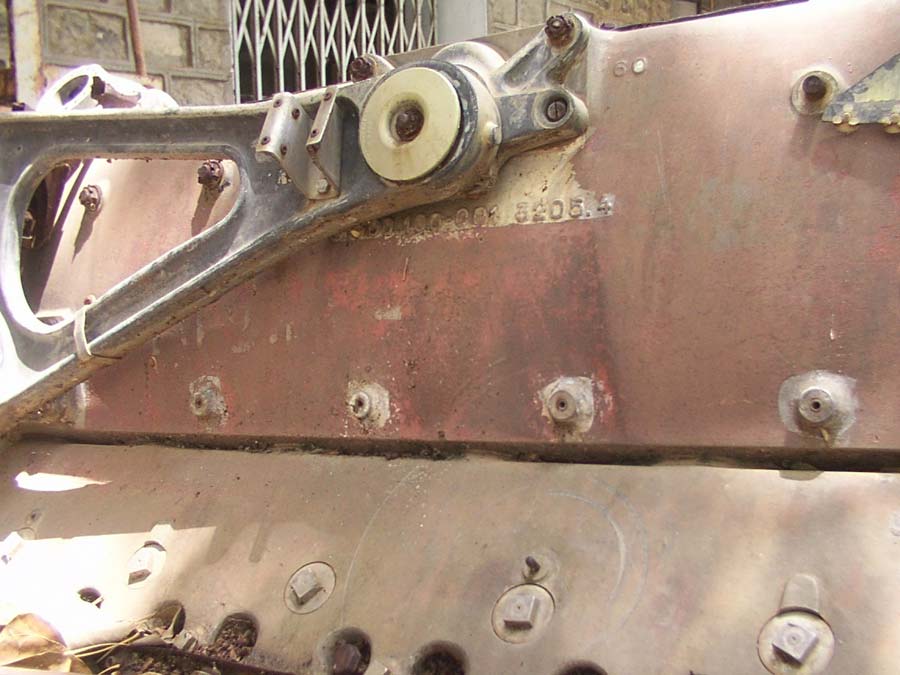
|
|
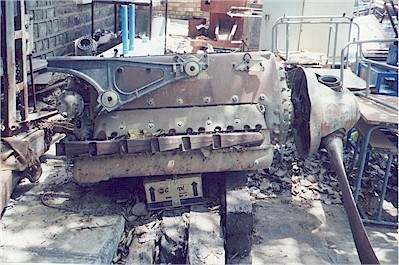
|
...but this pic is another matter altogether! In the recent "Aeroplane" article, a more centered view of the engine and spinner assembly shows the spinner to be the "pointed" style with the covered aperture, and here one can clearly see remnants of red paint. Now, think back to the CEAR of Fw. Ray's E-1/B... |
|
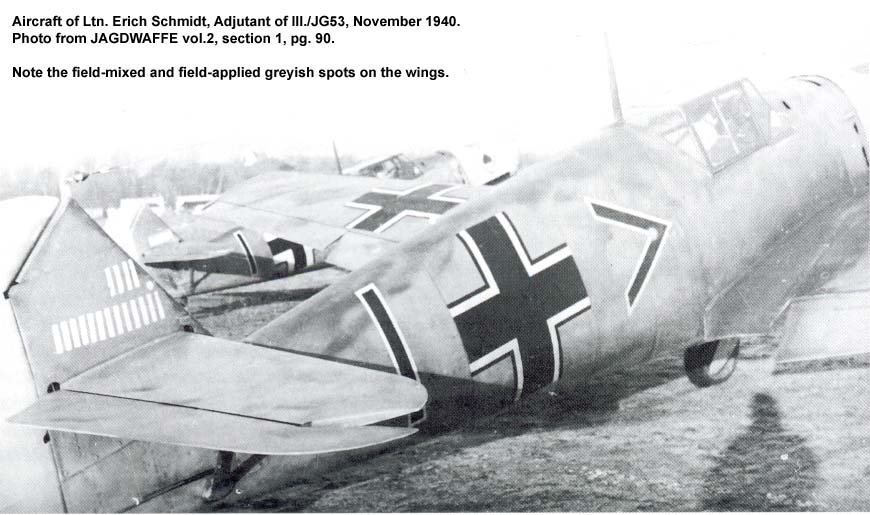
|
Now we start tying things together. This is a photo of the aircraft of Ltn. Erich Schmidt, Adjutant of III./JG53 taken in November, 1940. Clearly shown here are the large, narrow-bordered Balkankreuz, the lengthy III. Gruppe bar, and a fascinating field-modified mottled
camouflage scheme. This last observation is very relevant to the next two pictures... |
|
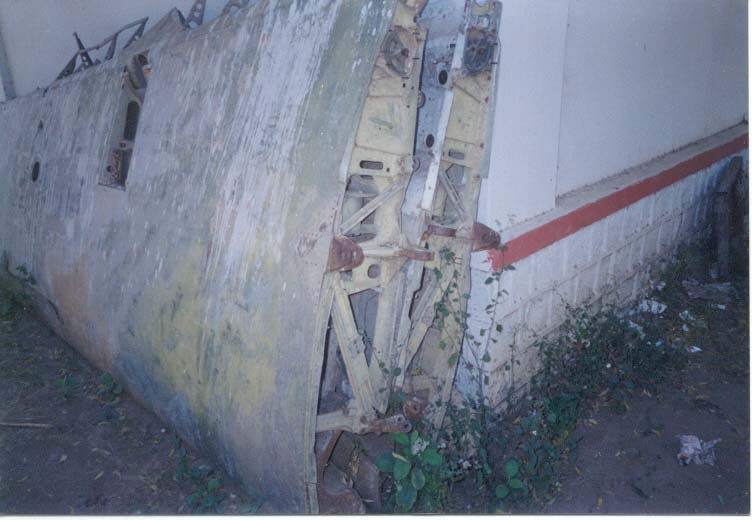
|
which show the wings of our mystery Emil stacked together. Note the soft-edged pattern to the uppersurface camouflage which has not worn away; note also the color and tone of the camouflage. Now, I refer you once again to the CEAR of W.Nr. 4034..."Camouflage yellow dappled green grey all over". This looks to be a mix of 02, and it certainly has a yellowish cast to it... and it's certainly mottled as well. |
|
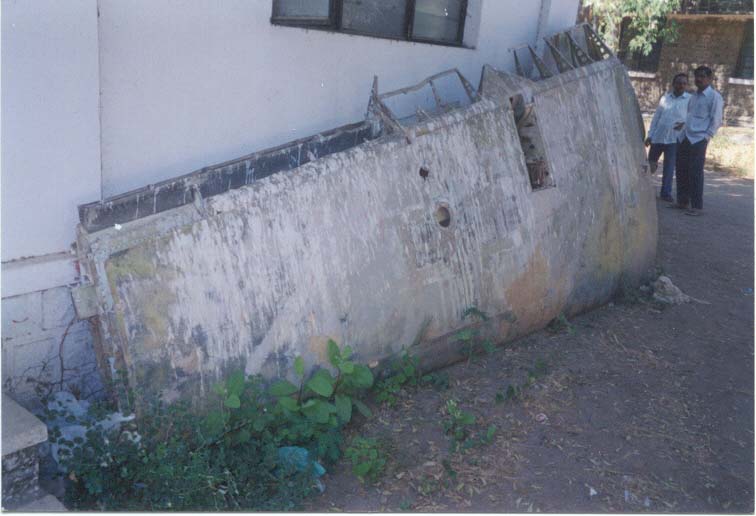
|
Of course, it wouldn't be a proper detective story if there weren't something to throw a spanner in the works... note the large patch of tannish paint on the forward part of the starboard wing
shown here. It's possible this may be 79, although personally I've got doubts about this. It appears to cover earlier camo applied there, so it may be something applied during its sojourn in India... we will have to wait and see on this one, I'm afraid. The midwing Balkankreuz from 1940 is visible, and the faint outlines of the outboard prewar cross can be seen as well. |
|
And the unmistakable "smoking gun" of the prewar unit identity...this
data block gives the unit and airfield to which said unit was assigned, as
well as a phone number. The Aeroplane article suggested the phone
number was an indication that the aircraft belonged to 9./JG52/53... this
is obviously incorrect. The fun part was filling in the blanks...
after some detective work through Michael Holm's superlative website at www.ww2.dk,
it was determined that I./JG77 under Hptm. Johannes Janke was based at
Breslau-Schöngarten between 1 May and 28 August 1939, which coincides
with the service entry of the E-1. In addition, the data block was
only present on prewar aircraft, for obvious reasons. Others who
have seen the aircraft later verified the upper line as mentioning
1./Jagdgeschwader 77.
So, there we have it!
|
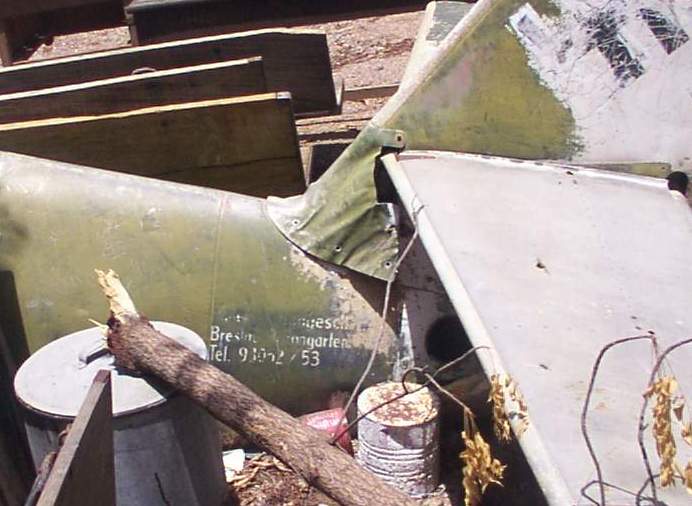
|
|
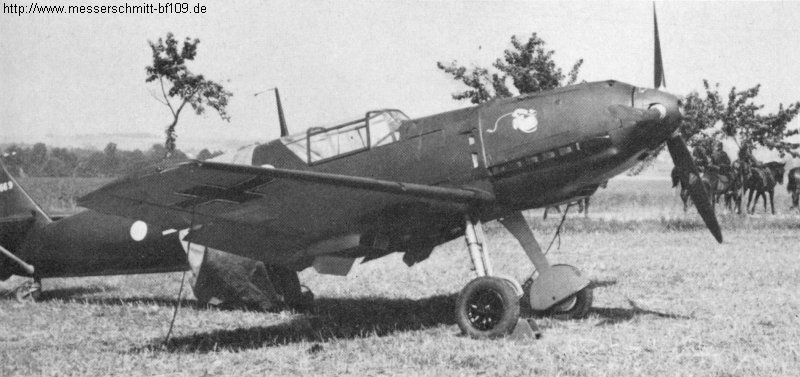
|
These last two photos
are included simply to show aircraft of I./JG77; of particular interest is
the placement of the W.Nr. midway up the fin on both sides. As can
be seen above, this is missing from the port side; it is hoped that a
little careful work with some wet/dry fine grade sandpaper might reveal a
number on the starboard side of the fin. |
|
Finally, I would like
to offer my heartfelt thanks to Jagan Pillarsetti of Warbirds over India
and Peter Arnold for the photos of "4034" seen here; and Paul
McMillan, Dave McDonald, Mark Sheppard, and the ever-helpful Dave Wadman
for their contributions to the discussion as well. |
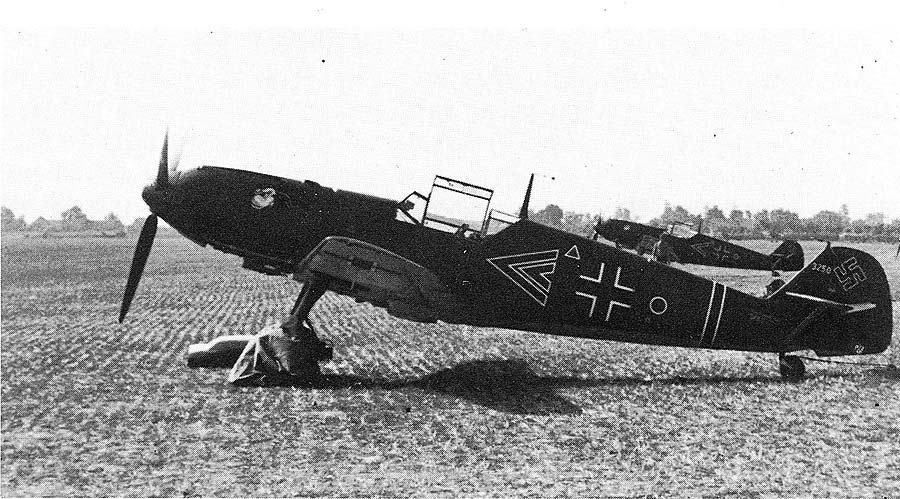
|










